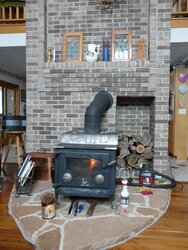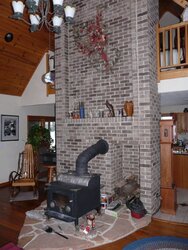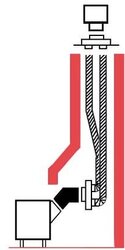I've been burning wood since 1979 in what was the largest model stove that Woodland offered back then. Large door with glass, room air for combustion. In a drafty old farmhouse it worked just fine. In the mid-90's we moved into a mostly airtight new house, so I modded the stove to use outside combustion air. Instead of building a fireplace, we built a large central chimney and parked the stove on a stone hearth in front of it with a stovepipe into the flue. The house also has a gas furnace and we don't depend entirely on the stove, using it to provide supplemental heat and reduce gas usage. But on a few occasions when the furnace has conked out (usually on the coldest day of the winter) or the power failed, the stove has prevented an inconvience from becoming a crisis. Typical usage is around 3 cords per season.
Here's the arrangement:


There are 2 other unused flues in the chimney that were included for possible future stoves.
Time marches on, and so does arthritis and other aches and pains. While we thoroughly enjoy the stove each winter, the cutting, hauling, splitting and dealing with the mess doesn't hold as much charm as it used to. I've finally begun to think about switching to some kind of gas unit. Ventless seems quick and easy, but I have reservations about using room air for combustion and also venting the humidity into the house. Direct vent addresses those concerns, but raises the question of how or if it could be integrated with the existing chimney arrangement. I've also wondered about installing a gas log into the existing stove that would continue to utilize outside combustion air, but there'd have to be a way to protect the valve & controls from the heat. Also, I don't know anything about the use of gas logs, how much heat output can be achieved, getting the correct flame, etc.
I'm sure other folks have been down this road & had the same concerns, and I'm hoping someone has ideas and suggestions.
Thanks,
PP
Here's the arrangement:


There are 2 other unused flues in the chimney that were included for possible future stoves.
Time marches on, and so does arthritis and other aches and pains. While we thoroughly enjoy the stove each winter, the cutting, hauling, splitting and dealing with the mess doesn't hold as much charm as it used to. I've finally begun to think about switching to some kind of gas unit. Ventless seems quick and easy, but I have reservations about using room air for combustion and also venting the humidity into the house. Direct vent addresses those concerns, but raises the question of how or if it could be integrated with the existing chimney arrangement. I've also wondered about installing a gas log into the existing stove that would continue to utilize outside combustion air, but there'd have to be a way to protect the valve & controls from the heat. Also, I don't know anything about the use of gas logs, how much heat output can be achieved, getting the correct flame, etc.
I'm sure other folks have been down this road & had the same concerns, and I'm hoping someone has ideas and suggestions.
Thanks,
PP



